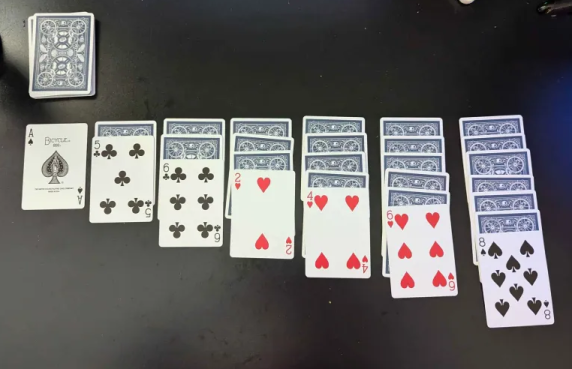
Solitaire
Type: Card game
Player count: Max of One
you know, i've never really been one for direct, head-to-head competiton. and with a deck of cards, pretty much every game you can think of is some sort of contest between multiple people. but while you guys are challenging each other and "socializing," i've been sitting over here playing the BEST card game, Solitaire. with it's earliest recorded sightings being somewhere in the late 1700's, Solitaire is easy to call a certified classic, it's also easy to call it by its other names, like "Klondike" or "Patience," if you're some kind of weirdo. it's the easiest card game to get into, since you don't need friends to play it. instead of being about bluffing or luck or whatever, Solitaire is pure planning and skill, and that's why i like it. except for when you get dealt a bad card setup. but like, for the MOST part it's all skill.
now, the classic Solitaire experience is best enjoyed with a deck of cards and a good idea of the rules, but there's plenty of different e-Solitaires in the world to check out. some that come to mind are the classic Windows version, the one in Last Call BBS, the version in Brain Age: Concentration Training (which is another game i want to cover in this section... some other time, though) and Polyrhythm Mania's Built To Scale Solitaire. for today's review however, i'll be talking about the classic version everyone knows and loves, so let's delve right in.
Solitaire is played like this. the part outlined in red is your foundation piles, and is your win condition for the game. you must stack each card into the foundation piles in order of number, so you'd go Ace, 2, 3, 4, 5, etc., and they all must be of the same suit in each pile. so in the example photo, you could move the Ace of Spades to the foundation piles to start the Aces foundation. the part outlined in green is the tableau, and is where most of the action happens. you see, to access the cards you want to put into your foundation, you'll have to find them in the tableau first, and make sure they aren't beneath any other cards. so in the example photo, you would only be able to move the cards that are on the top of the stack in the tableau. but where can you move them? good question! you can only move cards in the tableau to be on top of cards of the opposite color, and in descending order. so in the example photo, you would be able to put the red 4 on top of the black 5. but you couldn't put the black 5 on top of the black 6, since they're not opposite colors. you could put the black 5 on top of the red 6, however. but let's say you can't make anymore moves in the tableau. what then? well that's where the stock pile comes in, which is outlined in yellow. you take a card from the top of the stock and place it in the blue outline, or the waste pile. you can then move the card at the top of the waste pile as if it were in the tableau, accounting for any of the rules that enforces. the game of Solitaire concludes when every card has been put in its proper foundation. it's definitely a lot to remember, but once you've played a few games, it really does begin to click. if you're having trouble remembering the rules, my suggestion is to play a couple rounds of e-Solitaire where the rules are strictly enforced.
Solitaire is best enjoyed when you've got nothing else to do. it's kinda like Minesweeper, in that sense. but i don't mean that in a bad way towards either of them, believe me. moreso i mean, it's something that's simple to start up, get into, and drop in an instant if you need to do something else. but it's addicting enough that if you're trying to pass a long amount of time, you aren't gonna get super bored of it. it's some really good stuff. you feel so unbelievably smart when you're struggling to see where you could go next with a game, only to finally figure out a solution and finish up each foundation after that. Solitaire is a classic for a reason.